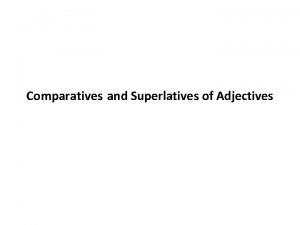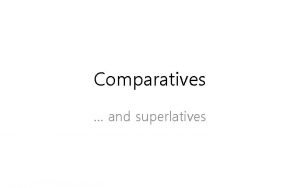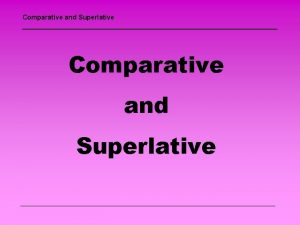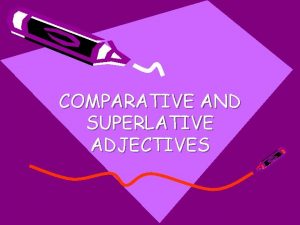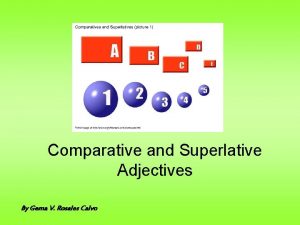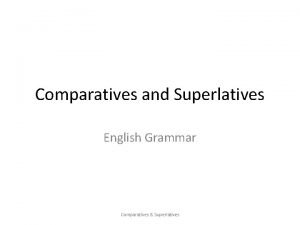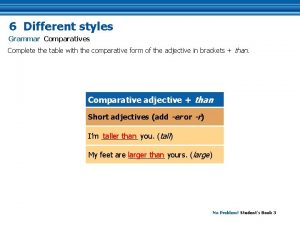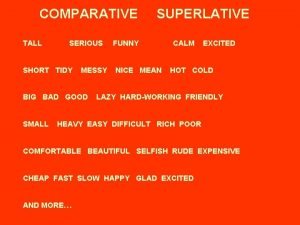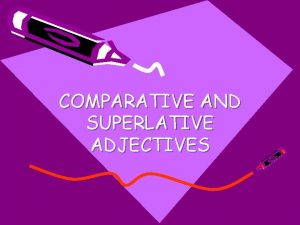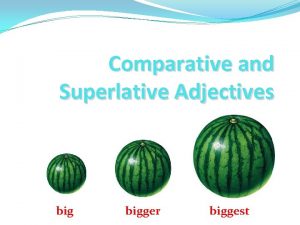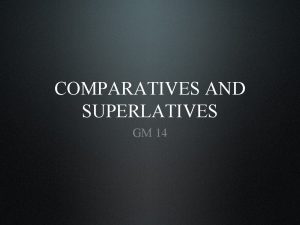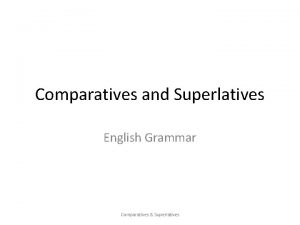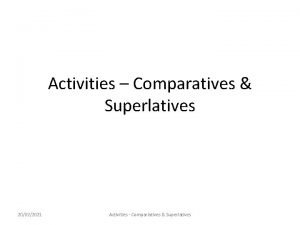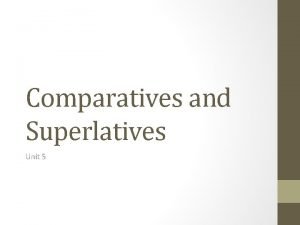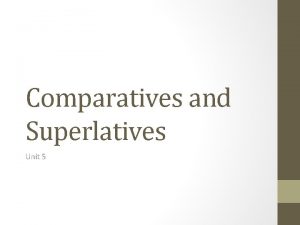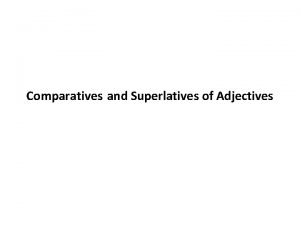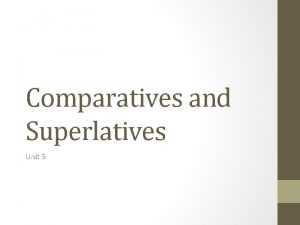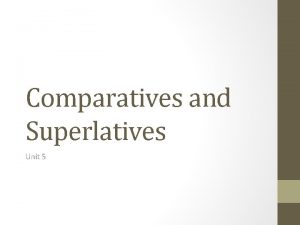COMPARATIVES AND SUPERLATIVES GM 14 Content Introduction Regular




















- Slides: 20

COMPARATIVES AND SUPERLATIVES GM 14

Content • Introduction • Regular comparatives • Regular superlatives • Imperfect (defective) adjectives • Irregular superlatives • Textbook

Introduction • A great part of adjectives has an ability to create two forms which express higher degree of quality: comparative and superlative. English German Italian French Portuguese Greek Latin positive good gut buono bon bom καλός bonus comparative better besser migliore mellieur melhor καλύτερα melior superlative the best der beste ottimo le mellieur ó(p)timo/o melhor ο καλύτερος (από όλους) optimus

• Comparative is the form of an adjective used to compare two things. • the muscle is longer (than the other one): musculus longior. • a shorter sinew (shorter than another sinew): ligamentum brevius.

• The superlative has two meanings in Latin: 1. An ordinary superlative is used to express which thing has the quality above or below the others (there must be at least three things to use the superlative). • the longest muscle (of all the muscles in a body): musculus longissimus. • the shortest sinew (of all the sinews …): ligamentum brevissimum.

2. So called “elative” meaning: • it has exactly the same form as an ordinary superlative. • but it is not used for comparison. Instead it expresses a very high degree of quality: • a very different symptom: symptoma difficilimum. • a very long muscle: musculus longissimus. • a very short brevissimum. sinew: ligamentum

• If we use a superlative in medical terminology the meaning is usually the elative one. • There adjectives that create neither comparatives nor superlatives. Example: adjective biceps means literally “with two heads”, there is no sensible comparative or superlative. • In certain cases the superlative and comparative meanings are questionable (white, more white, the most white).

• In Latin the basic form of adjective from which we create comparatives and superlatives is called “positive”. • There adjectives that lack a positive form and have only comparatives and superlatives.

Regular comparative in Latin • So far we have discussed two groups of adjectives: • type longus, a, um (uses endings from the 1 st and 2 nd declension) and • brevis, e (endings from the 3 rd declension). • Both groups of adjectives create comparative in the same way. • Comparative forms of adjectives have endings according the 3 rd declension paradigm dolor and caput. (This is true even if the adjective in basic form is inflexed according the 1 st and 2 nd declension. ).

• To create a comparative we must: 1. identify the stem (i. e. in longus, a, um the stem is long-) 2. add -ior 3. append the ending (if there is any). • There is exception from this procedure in Nom. a Acc. Sg. for neutrals where instead of -ior- we use ending ius.

Regular comparatives M/F Nom. long -ior Gen. N long -ius long -ior- is Acc. long -ior- em long -ius Abl. long -ior- e M/F N long -ior- es long -ior- a long -ior- um long -ior- es long -ior- a long -ior- ibus Note Nom. and Acc. for neutrals in Sg. where the ordinary -ior- is missing. Also note that the suffix follows exactly the dolor/caput paradigm.

Regular superlative in Latin • Both groups of adjectives regardless their original declension use endings from the 1 st and 2 nd declension to create superlative form. • The superlative is created by inserting -issim- in front of the suffix. • In comparison with previous paradigm there is no exception in neutral form.

Regular superlative in Latin singular M F N Nom. long -issim- us long -issim- a long -issim- um Gen. long -issim- i long -issim- ae long -issim- i Acc. long -issim- um long -issim- am long -issim- um Abl. long -issim- o long -issim- a long -issim- o

Regular superlative in Latin plural Nom. Gen. M F N long -issim- i long -issim- ae long -issim- a long -issim- orum long -issim- arum long -issim- orum Acc. long -issim- os long -issim- a Abl. long -issim- is

Defective adjectives • They are used in anatomy mainly to indicate space relations (forward, backward, upper, lower, external, internal, …). • Defective adjectives have not the positive form. They have only comparative and superlative forms. • However meaning of comparative form is usually equal to English positive. • They are grammatically regular (i. e. use normal comparative set of endings).

• Following defective adjectives are required: • superior, ius (upper) • inferior, ius (lower) • anterior, ius (frontal) • posterior, ius (rear, caudal) • exterior, ius (outside) • interior, ius (inside) • Further details (and superlative forms) can be found on the page 183 - 184.

Irregular superlatives • Two groups of adjectives have irregular superlatives: • Every adjective that terminates in nominative case of its basic form (positive) for masculines with ending -r creates superlative with -rrimus instead of -issimus. • Adjectives similis, dissimilis, facilis, difficilis (identical, different, simple, difficult) create superlatives using -llimus.

Regular superlative (brevis, e) Irregular superlative (acer, is, e) brevissimus brevissimi brevissimum brevissimo acerrimus acerrimi acerrimum acerrimo difficillimus difficillimi difficillimum difficillimo brevissimi brevissimorum brevissimos brevissimis acerrimi acerrimorum acerrimos acerrimis difficillimi difficillimorum difficillimos difficillimis Irregular superlative (difficilis, e)

Entirely irregular comparatives positive comparative superlative good bonus, a, um melior, ius optimus, a, um bad malus, a, um peior, ius pessimus, a, um big magnus, a, um maior, ius maximus, a, um small parvus, a, um minor, minus minimus, a, um Four adjectives create comparative and superlative forms using different stems. Endings have ordinary grammar. So bonus, a, um is on the basis of longus, a, um; its comparative melior, ius uses dolor/caput paradigm, and finally superlative optimus, a, um follows again longus, a, um paradigm.

Textbook • For related grammar see p. 180 - 184.
 Warm superlative
Warm superlative Comparatives and superlatives exceptions
Comparatives and superlatives exceptions Superlative form of easy
Superlative form of easy Superlative colourful
Superlative colourful Complete the review with the comparatives or superlatives
Complete the review with the comparatives or superlatives Comparative and superlative de comfortable
Comparative and superlative de comfortable Forming comparatives and superlatives
Forming comparatives and superlatives Generously comparative and superlative
Generously comparative and superlative English grammar comparatives and superlatives
English grammar comparatives and superlatives Comparative adjectives handsome
Comparative adjectives handsome Nice comparative and superlative
Nice comparative and superlative Complete the table of the comparatives and superlatives
Complete the table of the comparatives and superlatives Comparative adjectives examples
Comparative adjectives examples Comparatives safe
Comparatives safe Comparative adjective fierce
Comparative adjective fierce Superlatif de serious
Superlatif de serious Dangerous superlative adjective
Dangerous superlative adjective Big comparative and superlative
Big comparative and superlative Diligent comparative and superlative
Diligent comparative and superlative Regular superlatives
Regular superlatives 1 syllable adjectives
1 syllable adjectives


